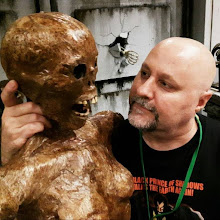Considering this week of 31 Days of Horror (2014 edition) will be devoted to pop culture lycanthropes, I figured, why not take a look at the first werewolf movie ever made? The Werewolf, released on December 13, 1913, is actually a Canadian production--which makes it all the more relevant to this blog! The film is now considered lost, but enough information has been uncovered over the years to piece together a pretty solid overview of the production. (I should note that this slate is not from the film; I created it for illustration purposes...)
[2017 update: the 101 BISON slate above, which is a mock-up I created for this blog post, has now been propagated across the Internet as being a real slate from this lost film. Oops!]
Although The Mask (1961) was technically Canada's first feature-length foray into horror filmmaking, The Werewolf predates this by almost fifty years. Shot at the Universal Ranch in Los Angeles, the story features Watuma, a shape-shifting Native American woman, who seeks vengeance on the reincarnation of the man who murdered her lover a century earlier.
 |
| SheliakBob / The Classic Horror Film Board |
In 2013, a silent film enthusiast named SheliakBob uncovered the above photo from The Universal Weekly magazine, Vol.3 No.24 (December 1913). I enhanced his original scan in order to improve on the clarity of the photograph. He also posted the official synopsis, which I've reproduced at the end of this post. The cast included: Clarence Burton as Ezra Vance, Prospector and Trail Blazer; Marie Walcamp as Kee-On-Ee, as a Young Woman; Phyllis Gordon as Watuma, daughter of Kee-On-Ee; Lule Warrenton as Kee-On-Ee, Years Later; Sherman Bainbridge as Stone Eye; and William Clifford as Jack Ford.
 |
| Henry MacRae (magnoliabox.com) |
Moving Picture World (Vol. 18 No. 10, December 6, 1913) had this to say about the film: "For those who care much for shooting and massacre the picture will have appeal. Good photography and interesting backgrounds go far to hold the attention. [But] the spectacle of a large body of Indians standing in a compact mass and shooting at a party of white men is hardly in accord with Indian tradition."
The story, written by Ruth Ann Baldwin, was loosely based on Honoré Beaugrand's "The Werwolves" [sic] (1898), which first appeared in English in the October, 1898 edition of The Century magazine. (I should note that this story is often attributed to Henry Beaugrand (1855-1929), who seemingly did not exist outside of being erroneously noted as the author of this work.) This narrative folk tale takes place on Christmas Eve in 1706, with officers stationed at Fort Richelieu, Quebec, trading fantastic tales spurred on by the belief that there is a group of loups-garous lurking outside. Beaugrand's short story has been reprinted a handful of times over the decades, including as part of Peter Haining's Werewolf: Horror Stories of the Man Beast (1987). This now seems to be out of print; if you're in Toronto, you can find it at the Merril Collection of Science Fiction, Speculation & Fantasy.
Here's the official synopsis of the film, transcribed by SheliakBob:
The play opens in pioneer days. Kee-On-Ee, an Indian maiden is married to Ezra Vance, a trail blazer. When her child is five years old, Kee-On-Ee is driven back to her tribe by Ezra’s brother, who scorns all squaws. Ezra is killed by an old enemy and Kee-On-Ee, thinking his failure to return to her to be indifference, brings up her child, Watuma, to hate all white men.
When the child is grown, Clifford and a party of prospectors appear. Kee-On-Ee, now a hag, sees her way to be revenged. She sends her daughter to Clifford’s camp and he is driven nigh mad by her beauty. Clifford finds her in the arms of a young Indian. She taunts him. Enraged beyond control, Clifford shoots the buck. He flees to the mission. Watuma leads the enraged Indians against the Friars. When one of them raises a cross, Watuma slowly dissolves into a slinking wolf.
A hundred years later, Clifford, now reincarnated in the form of Jack Ford, a miner, receives a visit from his sweetheart, Margaret. Hunting with her he comes upon a wolf which he is unable to shoot. The wolf dissolves into the woman of old, and there appears before his puzzled eyes the scene where he slew the Brave. The “Wolf-woman” would caress him, but he throws her off. She returns again as the wolf and kills his sweetheart. Clifford’s punishment for the deed of past life is made complete at the death of the one he loved.








0 comments:
Post a Comment